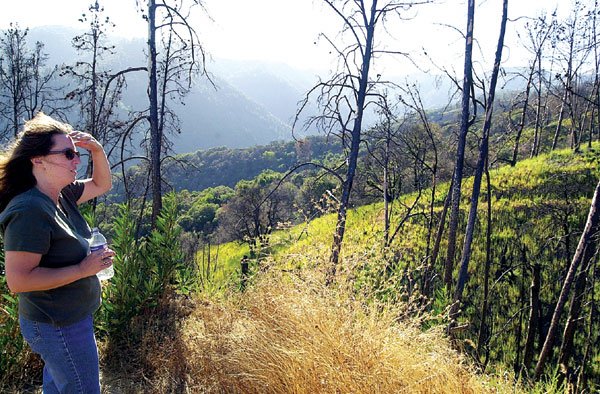GILROY
– Kersty Daniels looks at the charred redwoods, pines and
chaparral that cover the slopes of the Santa Cruz Mountains from
where her two-story home burned down one year ago, and she feels
renewed.
GILROY – Kersty Daniels looks at the charred redwoods, pines and chaparral that cover the slopes of the Santa Cruz Mountains from where her two-story home burned down one year ago, and she feels renewed.
Between the dead twigs that jut out from the blackened tree trunks are budding green branches, reminding her that Mother Nature is rebuilding herself. It gives Daniels the slim hope that she and her husband, Russell Cox, can rebuild their lives, too.
It’s been 365 days since the couple dwelled happily in these hills with their dogs and cats away from bustling Silicon Valley, overlooking their own lush ravine from their deck. Sadly, given the financial and political obstacles this couple, and many other families, face in putting their lives back to normal, Cox and Daniels may be in the same predicament another 365 days from now.
The sense of renewal fades and a crushing reality sets in: Today, they rent a Sunnyvale home on a busy street that doesn’t fit their blue jeans and ponytail image, and they pay a mortgage on their house that no longer exists. Their temporary Sunnyvale home doesn’t even fit their dogs’ senses of normalcy as the animals regularly jump the fence to brashly explore the neighborhood, but wind up needing rescue from the pound.
One year after the Croy Fire engulfed their home along with 33 other structures among the 3,127 scorched acres, Cox and Daniels describe their lives now in one word – limbo. In those half-dead trees and their stunted outdoor dogs, it’s irony they see.
“Sometimes I see light at the end of the tunnel, but I need a bright light because this dim one is not going to do it for me much longer,” Daniels says.
Rebuilding homes that don’t exist
After Croy raged through the hills west of Morgan Hill from Sept. 23 to 29, 2002, Santa Clara County learned about a number once described by a county supervisor’s aide as “appalling.” Of the 34 homes and structures lost in the fire, only two of them had permits.
For decades, property owners had built on the hillsides, out of view of county inspectors. It was illegal, but as long as neighbors didn’t report one another and as long as county inspectors didn’t survey the area – they just about never did – no one ever got in trouble.
The county has said it will maintain its policy of responding to violations only when there are complaints. However, with more of a spotlight on the area, neighbors are reluctant to rebuild their homes without county approval. And, residents claim getting county approval is next to impossible.
Just in road improvements that would meet county standards, permit requirements would cost upward of $1 million, residents say.
“Everybody’s in a kind of wait-and-see holding pattern right now,” says Roy Guist, who lost his home in last year’s blaze.
Guist claims the county guidelines never made it possible to build legally in the hills because mountain residents were being held to flatland standards.
For a couple who lost their dream home, the Guists are fortunate. Their home was paid off, they had insurance, and the insurance company bought them the Morgan Hill home where they now live.
They are not in the time sensitive predicament of Cox and Daniels whose insurance company, they said, wants to settle with them to avoid paying their Sunnyvale rent indefinitely. Cox and Daniels figure the money they get from the insurance company won’t be enough to replicate their home and will be surely too little to fund road improvements.
For the Guists, their main problem is location, not time. They’d rather live on their 40 acres in the Santa Cruz Mountains than in Morgan Hill.
“It’s a nice home that we’re in now, but it’s different. We want to be back here drinking ice tea,” Sue Guist says, referring to the shaded area between two goose ponds Roy Guist built.
For now, they have to be satisfied with the rebound the land is making. Trees and shrubs grow all around the couple’s land. Dried, 3-foot high stalks of wheat now surround the manzanitas that burned and exploded last September.
“So much of the vegetation up here thrives after a fire,” Roy Guist said.
Guist had a hand in part of the rebound. The two ponds, which are home to three geese, are now refilled to their 25,000- and 40,000-gallon levels. They were dry after the fire because Guist used them to wet his property as flames approached his home, but the effort was to no avail.
Solutions
Some residents have reluctantly found a solution to the permitting obstacles: Build without them.
It’s remarkably easy to build or buy a code-quality home and get it insured without county approval. It’s even possible to get on the county tax rolls without permits.
According to a damage report by the county and California Department of Forestry, there were 99 residential structures on 60 parcels directly exposed to the fire. Thirty-four were destroyed – including 13 houses, 15 trailers and six mobile homes.
While some of the homes remain razed, some have been rebuilt, too. Yet, the accompanying permits remain unpulled.
“As of (September 2003), we haven’t issued any permits for residential building,” County Inpsector Tom Avon said.
“That’s part of our frustration. We feel we did everything right. We paid taxes on the property (even though the preceding owners likely did not). We called the county to see what we needed to do to get permits, and they told us ‘We don’t issue permits there,’ ” Daniels said. “I’m almost ready to throw in the towel and just put up a prefab home or sell the property altogether.”
Steve Slusser, who does and has paid property taxes, owns one of the residences that has been rebuilt in recent months. He didn’t get permits since he knew road improvements would be cost prohibitive and so far no one from the county has paid him a visit.
“I built it expecting there’d be a conflict at some point, but I was tired of living in a 26-foot trailer,” Slusser said. “I just hope we can all be reasonable people and the county tries to find a win-win situation for everybody.”
There may be a win-win solution if the county is able to bend its rules a little, by permitting home construction if the roads are made strong and wide enough to meet CDF standards. CDF standards are not as stringent as county standards, making the work more affordable.
“There are people here who would probably volunteer to do some of the actual construction work. We’d just need some guidelines from a certified engineer,” Cox said.
To help pay for any costs involved, Croy residents could form a road association that taxes residents for road maintenance and upkeep. The move would not be unprecedented; a neighborhood nearby, Casa Loma/Loma Chiquita, years ago formed such a road association.
While the rougher terrain in the Croy area makes road improvements more difficult than in Casa Loma/Loma Chiquita, residents point out that during the Croy Fire CDF trucks were able to traverse much of the area.
County Supervisor Don Gage, who oversees the area, says he is open to such a compromise.
“The neighbors need to contact my office and set up a meeting with me to start theses discussions,” Gage said.
For the Guists, Cox and Daniels, Gage’s promise is met with a sigh. They say they’ve heard the words before, but acknowledge there haven’t been intensive talks between the CDF, the county and the residents to see what would be affordable and passable by fire trucks.
“I’ll give Don Gage a call again. I’d like to spend about 30 minutes with him and talk to him about all the particulars,” Roy Guist said.
If nothing comes of the discussion, Cox and Daniels will likely try to join the Casa Loma association. By joining the association, they’d be agreeing to access their property through Casa Loma, but it is unknown if this would satisfy the county enough to grant them a housing permit.
“What we need is for the county to cooperate with us and want to get us back into our home,” Cox said.
For Sue Guist, the potential for the county and the residents to work something out is underscored by a tangible metaphor she wears daily. It is her platinum wedding ring that burned in the fire and remains tarnished from the flames.
The ring broke years ago, remaining unworn, a sad reminder of a time in the Guists’ marriage when their relationship seemed broken, too. The intense heat of the fire welded the ring back together. It shrunk in the heat, but still fits over Guist’s pinky, a happy reminder that the couple feels whole again in their 53rd year of marriage.
“It reminds me that everything will come together again,” she said.














